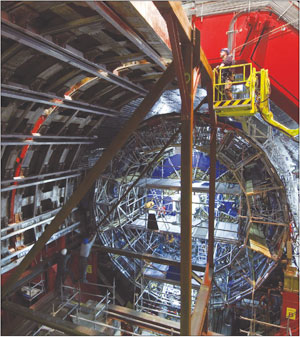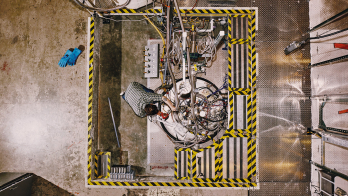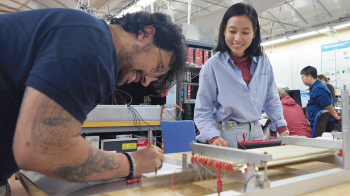Peter Jacobs describes the electromagnetic calorimeter that will study jets.
The best-known goal of the LHC is the exploration of the “energy frontier”, using proton collisions at unprecedented beam energy and luminosity. Equally ground-breaking, the LHC will also explore the “energy density frontier” via the collision of lead nuclei at 5.5 TeV per nucleon pair. This is 30 times the collision energy of the Relativistic Heavy Ion Collider (RHIC) at Brookhaven, which is currently the world’s highest-energy nuclear accelerator. The LHC will thus extend the study of the quark–gluon plasma (QGP) and phase transitions of the strong interaction into a qualitatively new regime of temperature and density.

One of the most striking results to emerge from RHIC is the discovery of “jet quenching”. Jets are the remnants of hard scattered quarks and gluons from the collision. They are collimated sprays of stable particles (pions, kaons and the like) that occur in all types of high-energy collisions. Jets are fundamental to QCD, the underlying theory of the strong interaction, and were clearly identified for the first time by the UA1 and UA2 experiments at the SppS collider at CERN in the early 1980s. Heavy-ion collisions bring a new aspect to jet studies, because the hard scattering occurs in the midst of the hot QGP fireball. Consequently, the jet must plough through the plasma, interacting with it and losing energy, before emerging into vacuum and “fragmenting” into the stable particles seen in the detector. The process of energy loss in the plasma, known as jet quenching, modifies strongly the jet structure that is seen in proton–proton collisions. Such modifications can be calculated theoretically using perturbative QCD (pQCD), and a comparison of these calculations and jet measurements in nuclear collisions has provided an invaluable tool for looking into the early moments in the life of the QGP.

Image credit: Mona Schweizer for CERN.
Soon after teams at the RHIC announced the initial results on jet quenching, researchers in Europe and the US began to explore ways to make similar measurements at ALICE, the only LHC detector expressly designed for high performance in the fearsome environment of high-energy nuclear collisions, where a single lead–lead collision can generate some 50,000 individual particles. The ALICE detector will measure a range of signals from the QGP, but its baseline design did not include a large-area calorimeter, which is essential for the study of jet quenching. However, the designers of ALICE had the foresight to reserve space for a calorimeter to be added as an important complement.
Detector requirements for jet quenching differ from those for more familiar measurements in high-energy physics, where hermetic calorimetric coverage is needed. The jet quenching signal lies in the modification of the distribution of particles within each jet, and this requires the sophisticated charged-particle tracking and particle identification capabilities that are specialities of ALICE. A large electromagnetic calorimeter (EMCal) would provide ALICE with a fast trigger for high-energy jets, together with a measurement of neutral particles in the jets (primarily neutral pions), which are not seen by ALICE’s charged-particle tracking system.
In 2005, US researchers interested in participating in the ALICE experiment requested funding from the US Department of Energy. They were then joined by groups from France and Italy, and in 2006 the international ALICE EMCal proposal was endorsed by the LHC committee. Funding is now in place on both sides of the Atlantic to complete the EMCal in time for the major lead–lead runs.
The ALICE EMCal is a lead-scintillator sampling calorimeter comprising almost 13,000 individual towers that are grouped into 11 “super modules” (SMs) for ease of handling and installation. The towers are read by wavelength-shifting optical fibres in a “shashlik” geometry, coupled to the same type of avalanche photodiode sensor that is used in the electromagnetic calorimeter in the CMS experiment at the LHC. The EMCal contains 100,000 individual scintillator tiles and 185 km of optical fibre, and it weighs about 100 tonnes. Three SMs will be constructed in Europe, with the remainder built in the US. As the SMs are completed they will be slipped into the EMCal support structure like cassettes. The support structure is a complex object: it weighs 20 tonnes and must support five times its own weight, with a maximum deflection of only a couple of centimetres.
The EMCal covers the full length of the ALICE time projection chamber and central detector and a third of its azimuth, and it is situated back-to-back with the smaller, highly granular lead tungstate calorimeter of the ALICE Photon Spectrometer. With the fast trigger provided by the EMCal, ALICE will measure jets in lead–lead and proton–proton collisions to energies well beyond 200 GeV, enabling a comprehensive set of measurements of jet quenching using ALICE’s unique capabilities.
Synchronization of this early upgrade with the ALICE construction and LHC operations schedule has been challenging. Much of the early work of the EMCal group focused on designing and building the mechanical support structure that had to be installed during the initial ALICE assembly. In addition, beam tests of mature prototypes at Fermilab, and at the SPS and PS at CERN, have verified the module performance. Attention is now turning to construction of the SMs, with the first modules available for installation in early 2009. The collaboration aims to complete the full detector in time for the LHC run in 2011 or if all goes smoothly, the run in 2010.








